7 /10 1 Votes
Country United Kingdom Series Oswald Bastable Originally published 1974 Preceded by Warlord of the Air Cover artist Christopher F. Foss | 3.5/5 Goodreads Language English Publication date 1974 Followed by The Steel Tsar | |||||||||||||||||||||||||||||||||
 | ||||||||||||||||||||||||||||||||||
Publisher Quartet (UK)
Doubleday (US) Media type Print (hardback & paperback) Genres Novel, Science Fiction, Speculative fiction, Alternate history Similar Michael Moorcock books, Science Fiction books | ||||||||||||||||||||||||||||||||||
The Land Leviathan is a sci-fi/alternate history novel by Michael Moorcock, first published in 1974. Originally subtitled A New Scientific Romance, it has been seen as an early steampunk novel, dealing with an alternative British Imperial history dominated by airships and futuristic warfare. It is a sequel to Warlord of the Air (1971) and followed by The Steel Tsar (1981). This proto-steampunk trilogy is also published as the compilation volume A Nomad of the Time Streams.
Contents
Plot summary
The story of Oswald Bastable's adventures "trapped forever in the shifting tides of time" is framed with the concept of the book being a long lost manuscript, as related by Moorcock's grandfather. Several years after Bastable disappeared in 1910, the elder Moorcock travels to China in an attempt to track him down, meeting Una Persson of the Jerry Cornelius novels on the way who before disappearing leaves him a manuscript written by Bastable for Moorcock, relating what happened to Bastable after he unexpectedly left the elder Moorcock at the end of Warlord of the Air, probably bound for another alternate 20th century.
Bastable's story takes in a post-apocalyptic early twentieth century between 1904 and 1908, where Western Europe and the United States have been devastated by accelerated technological change caused by a prolific Chilean inventor, which led to a prolonged global war causing their reversion to barbarism. By contrast, South Africa. rechristened Bantustan, is ruled by President Mohandas Gandhi, has never had apartheid, and is an oasis of civilisation which stayed out of the conflict being an affluent, technologically advanced nation in this alternate, anti-imperialist twentieth century. To restore civilisation and social order in the afflicted Northern Hemisphere, a 'Black Attila', General Cicero Hood, leads an African army to beneficent if paternalist conquest of Europe and an apocalyptic war against the United States featuring the "vast, moving ziggurat of destruction" of the title.
The historical personage of our world appearing as alternate versions of themselves include:
Major themes
Martin Wisse noted that the book "is quite obviously a commentary on the 'yellow peril' and 'black peril' novel of the late 19th and early 20th century, with its unthinking racism, love of superweapons and willingness to commit genocide of the 'lesser races'. Here the formula is inverted, and the sympathies of the writer and reader are with Gandhi and the 'Black Attila', shown as a genuinely good man." They are contrasted with the impoverished, tribalised white supremacists of the devastated former United States, which has reintroduced African American slavery. Interestingly enough, Bastable accuses Hood of "genocide" though the word was not coined until 1943.
Publication history
It was first published in 1974 and has remained in print, in various editions, ever since.
